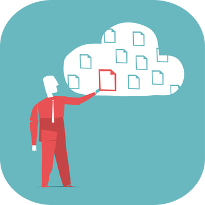 Disaster Recovery as a Service
Disaster Recovery as a Service
New options to help your business sustain itself should disaster strike.
Disaster recovery has moved to the cloud, and now you can leverage this solution to ensure that your files are protected and that your operational downtime is kept to a minimum. At Leonardo & Company we’ve been Illinois’s leader in backup and recovery solutions for some time, and now we can offer your organization a solution that will work to protect your business from the lost revenue that typically accompanies a data-loss event.
 Conferencing and Collaboration
Conferencing and Collaboration
Leonardo & Company has technology solutions designed to improve cooperation and collaboration.
The modern business needs to be able to leverage their tools, resources, and network connectivity to improve its productivity. At Leonardo & Company, we understand that today’s business is a mobile business, and we can help Illinois businesses procure communication and conferencing solutions that will allow for enhanced levels of productivity and greater inter-departmental synergy.
 Printer and Copier Support
Printer and Copier Support
Reduce your printing cost, increase your efficiency, and improve your document security.
Reliability. It’s a word that isn’t normally synonymous with printers and copiers, but at Leonardo & Company, our technicians understand that since these products can often be fickle, having access to expert support for them is important. Our technicians are trained in the installation and support of copy, print, scan, and fax solutions, providing your staff with the skills it needs to take control over machines that often seem to have a mind of their own.
 Understanding Automation - How We Leverage Automated Services
Understanding Automation - How We Leverage Automated Services
The strategic use of automation allows us to protect your business from harm.
Business technology is the bane of the modern worker. No matter how well-intentioned the members of your staff are, when they have computer troubles, it complicates everything they are trying to accomplish. This, in turn, complicates every goal you are trying to accomplish.
The automation of IT service delivery gives you a direct line to a stronger business by streamlining the services that your customers rely on. This is accomplished by removing downtime from the equation, while also securing your data and protecting your infrastructure. Since we only automate repeatable and routine tasks, it makes it so we can provide a comprehensive IT management service for an affordable monthly rate.
 Leonardo & Company’s Staffing Services
Leonardo & Company’s Staffing Services
Helping organizations find the right pieces for their needs.
As a solutions provider, we pride ourselves on helping organizations mitigate their operational problems. One of the major problems most organizations have is finding the talent they need to make their endeavor a success. Not all positions are created equal and sometimes the difference between relevance and insignificance is filling a key position with just the right person.
 Amazon Web Services
Amazon Web Services
Dynamic and secure cloud platforms proven to work for business.
As a member of the AWS Partner Network, Leonardo & Company makes available custom-purpose, enterprise-level cloud solutions to Illinois businesses. Thanks to the Amazon Web Services Partner Network, we are able to leverage one of the world’s most powerful cloud computing resources to help your business build an efficient, secure, and reliable cloud solution.
 Human Resources as a Service
Human Resources as a Service
A full-service HR department delivered for a low monthly rate.
If your business is growing, you won’t be surprised to find that the number of challenges you have to overcome compound over time. From hiring to firing, from payroll to administrative support, the human resources department is an integral aspect of a thriving business. Leonardo & Company has made a name assisting Illinois businesses build efficiency through technology, and now we offer a service that is designed to help organizations that are having a problems with their administrative processes.
 Data Warehousing
Data Warehousing
Manage your data in a way that can help your business thrive.
Leonardo & Company technicians work hard to protect our clients’ data. Our tried-and-true practices and expert technical knowledge have kept the data of several Illinois business’ safe and secure. With the expense associated with data security and redundancy, wouldn’t it be great if the data did more than just sit there waiting for someone to access it?
 Asset Tracking
Asset Tracking
Managing your business’ assets provides several key benefits
For the modern business to maintain efficiency, choosing the right software to fit your needs is more important than ever. As a result, many organizations look to piece together a comprehensive software strategy using several technologies. For the business that has a lot of moving parts, asset tracking software, as a part of a larger asset management strategy, can bring enhanced efficiency to what can be a very difficult-to-manage situation.
 Centrestack
Centrestack
Make Any Server a Cloud Server.
At Leonardo & Company, we pride ourselves on our ability to provide Illinois businesses with the right technology services to fit their needs. Many businesses today have begun to incorporate public cloud computing services as they look to manage technology costs and see rapid and sustainable returns off of their technology investments. Our Centrestack cloud computing solution allows any organization to “cloudify” their current onsite IT infrastructure, saving organizations the often substantial costs thatf implementing their own secure private cloud solution can present.
 Understanding General Data Protection Regulation Compliance
Understanding General Data Protection Regulation Compliance
In April of 2016, the European Union Parliament and Council voted to replace Data Protection Directive 95/46/ec and enact an overreaching data security regulation named the General Data Protection Regulation (GDPR). The law will go into effect in the May 25, 2018 and be the primary law regulating how businesses protect EU citizens’ personal data. Companies that need to meet the old security directive will need to be in compliance of the new law on that date or face stiff fines and other penalties
 Logistics and Supply Chain Management
Logistics and Supply Chain Management
Inefficiency is a problem and Leonardo & Company has solutions.
Data flow is important in all aspects of business. In supply chain management, inefficiencies in the flow of goods, components, or data, can stymie progress and cause costly downtime. Leonardo & Company provides technology services and solutions to Illinois businesses and can help the modern manufacturer build a fail-proof supply management system using some of today’s most dynamic business technologies.
 Access Control
Access Control
Secure your business with reliable access control solutions from Leonardo & Company.
The IT professionals at Leonardo & Company know that security is crucial for the modern business. That’s why our staff exhaustively works to put together comprehensive risk management strategies that serve today’s business needs. Since many businesses are beginning to turn to technology to secure all aspects of their operations, Leonardo & Company technicians have taken to offering technology-based physical security solutions, as well as solutions that protect an organization’s network and data.
 Virtual Desktop Infrastructure
Virtual Desktop Infrastructure
A cloud-based computing platform designed specifically for your business.
Today’s workers need more from their computing platforms. They need them to be consistent and redundant and, most importantly, available from wherever they are. At Leonardo & Company, we offer a virtual desktop infrastructure (VDI) platform that can transform your business by providing the custom computing interface, application deployment, and cost reduction that is attractive to both the modern company, and the modern worker.
 vCIO - Powerful Technology Strategies
vCIO - Powerful Technology Strategies
Let Leonardo & Company lead your technology initiatives with our vCIO services.
Leonardo & Company’s vCIO services present an angle that many smaller organizations lack, a dedicated technology officer. With technology being as large of an expense as it is, it is important that an organization’s technology budget is utilized effectively. For enterprise businesses, the role of the CIO is an executive-level position that carries with it a great deal of influence how these massive organizations spend their technology capital.

EManagement - Effective Project Management
Building more effective organizations through comprehensive project management.
Nothing is more frustrating to the modern business owner than unfulfilled expectations. The completion of projects is a big part of business growth. If you are having problems with the completion of your business’ projects, Leonardo & Company’s IT professionals can provide you with a solution via our e-management platform.

Business Intelligence Strategies
Make more informed business decisions.
You may think you know your business’ operations like the back of your hand, but wouldn’t it be advantageous to be sure? With Leonardo & Company’s Business Intelligence strategies, your organization can leverage our team of IT professionals to design and build a comprehensive business intelligence platform to completely change the way you look at your business.
 Business Computing Assessment
Business Computing Assessment
An expert inspection of your organization’s IT can get you started toward a better business.
If your business relies on information systems to function, and most businesses today do, you know just how quickly situations can arise with your IT. By having the experienced IT professionals at Leonardo & Company do a thorough assessment of your entire IT infrastructure, including onsite and cloud-based hardware and software systems, networking equipment, printers and copiers, and data storage facilities, you can get a comprehensive view of how your business works, and how those operations can be made more efficient through strategic improvements and properly managed and maintained business technology.
 Understanding Blockchain
Understanding Blockchain
The Technology Behind Cryptocurrency Will Do Much More In Time.
There are enough new technologies today that it can be hard to keep up with all of them. One technology that is leaving a lasting mark is blockchain. The technology behind the ever-popular cryptocurrency Bitcoin (and every other cryptocurrency), is quickly becoming a household name.
Here is a brief look into blockchain technology, how it works, and what kind of innovations businesses can use to make it work for them
 Profitability is less the measure of being able to turn a profit, and more the measure of how much profit you can make. For the successful small business, the integration of technology can dictate what kind of annual margins you are looking at. For the new company, however, it can be something even more critical: the difference between setting a course for success, or wallowing in failure. Today we analyze the cost difference between hosting your IT in-house, or choosing to host it in the cloud.
Profitability is less the measure of being able to turn a profit, and more the measure of how much profit you can make. For the successful small business, the integration of technology can dictate what kind of annual margins you are looking at. For the new company, however, it can be something even more critical: the difference between setting a course for success, or wallowing in failure. Today we analyze the cost difference between hosting your IT in-house, or choosing to host it in the cloud.
For this experiment, we’re going to assume that we are starting from scratch. The optimism and cautious excitement that goes into starting a new business endeavor is palpable. Let's assume for our purposes that you’ve determined that you need to support the following applications:
-
Email
-
Voice over Internet Protocol
-
Line of business applications
-
Productivity applications
-
HR and operations software
-
Storage (enough to support above)
-
File sharing
-
Backup
It’s not hard to ascertain the surface costs of implementing these technologies, but when trying to figure out the total cost of ownership, it may be a little more difficult. Objective comparison of the two platforms has to begin at their core needs. On one hand, In-house computing comes with several, including power, maintenance, management, and redundancy (and the management and maintenance of that platform), while cloud computing may need enhanced bandwidth and redundancy to work for a business. These costs have to be figured in when trying to plan your next steps.
Then there is the question of who is going to use your data, and what kind of protections need to be put in place as a result of that qualification. What compliance regulations does your organization have to meet? How many users does the network and infrastructure have to support? What software do you need to run? There are literally dozens of questions you have to ask before making any definitive decisions about what kind of hardware you are going to need, let alone what kind of hardware solutions you plan on using.
Once you’ve ironed out the particulars, you will then have to make the big choice. Do you want to buy physical hardware, cloud-based hardware, or some combination of both? Let’s analyze all three options:
In-House Computing
The first thing you have to be cognizant of is that once you decide that your organization needs in-house server infrastructure, you have to know that it is going to cost you a pretty penny. In order to support a full-scale communications solution, all the applications your business uses to do business, email, and backup you are looking at a seriously hefty price tag. Not only are you looking at a few thousand dollars per server, costs that are incurred in configuring the servers, warranties, and maintenance to that server could push the cost into untenable territory, especially if there isn’t a good deal of upfront capital available.
Beyond all that there are HVAC and security costs that need to addressed the first time around. The biggest expense, by far, is the cost of management. If you outsource your IT services management to a company like Leonardo & Company, you may be able to mitigate some of the recurring costs and get expert management, but ultimately the facts point to on-premise hardware rollouts costing a substantial amount more than utilizing cloud, especially with today’s IaaS costs.
Implementing an in-house server room does provide you with some pretty stark benefits, however. They include complete management over the systems within, the resulting comprehensive data security, and access to data without an Internet connection. It also front-loads the costs associated with the environment, so if the big capital expenses don’t cut into your operational budget considerations, you will be paying less per month. The infrastructure costs (which are fixed costs) and the management and maintenance of it, and operational costs (that are very often variable), all have to be taken into consideration, as does your organization’s regulatory compliance needs.
Cloud Computing
For the start-up that doesn’t have any overreaching data compliance issues, utilizing cloud computing is a no-brainer. Not only are there limited set up costs, there are so many different service-based computing plans that it is now possible to strictly use the cloud for all of your organization's central computing.
For the established company, it may be a little more difficult, so before we go “all hail the cloud!” on you, we have to admit that there are plenty of considerations you have to make if you were to go ahead with a completely virtualized computing infrastructure for your business. Here are a few:
-
Migration Time and Cost: Getting started with cloud computing may not come with the enormous capital costs that an inhouse server would, but there is cost, especially if you are migrating data. For an established business to move from physical servers to cloud infrastructure there is a substantial investment. It takes a lot of bandwidth and time to move all if an organization’s data over, and in doing so, you will likely incur a fair amount of cost.
-
Dependability and What Uptime Really Means: Cloud providers like to measure their effectiveness in uptime; and, in doing so, don’t properly represent what customers want from their cloud provider. Businesses need ubiquitous access to data and applications stored on a cloud construct, and sometimes that can be a problem. The VM running the server may be up, but if there isn’t access to critical information and applications, a business deals with their own downtime, which is a major problem.
-
Problems Estimating Costs: The cloud’s cost to a business seems simple enough, but a lot of business owners do a poor job of estimating the true cost of the service. With cloud computing pricing costing businesses so many cents-per-service-unit, they often fail to multiply this cost over months and years. By moving the least utilized applications over first, a company can save more money than just moving it all over at once.
-
Trusting Your Architect: Well before cloud implementation, a company would have a cloud architect make them a map (of sorts) so that decision makers can see how the data flows. A problem arises when you’ve trusted the plan and mid-implementation, the migration team wants to change everything. To avoid a complete cloud migration failure, your best bet is to consult with the architect to make certain that everything goes to plan.
-
Cloud security: For companies that migrate over to the cloud, they will have to know beforehand that all of the solutions they had deployed to protect their systems from threats are probably not going to be deployed by the cloud provider. As a result, it may initially feel as if the cloud construct is lacking security. Hiring a third-party to test your security will go a long way toward alleviating (or reaffirming) the concerns you may have about your cloud’s security.
As costs go, it’s pretty evident after considering all the factors, that deploying new infrastructure is always going to be costly. An organization can save money by moving to the cloud as long as the migration is done properly and meets all the file sharing, data security, and deployment needs that an organization has. In fact, most organizations have some sort of cloud project on the books for this very reason. The benefits outweigh the detriments for a lot of what companies do.
The Hybrid Approach
Nowadays, the Hybrid Cloud approach is becoming more popular. As data regulations increase and legacy software is still mightily functional, the best option is often to deploy both a cloud platform and keep an on premise server. Essentially, finding ways for the two to work in unison is called a hybrid cloud. While this seems like a match for nearly every business, it comes with a great deal of design and implementation headaches, and can cause significant cost overruns.
In order to design and deploy an effective hybrid cloud, you first have to know what the potential pitfalls can be. Two include:
-
Utilization uncertainty: When moving part of an organization’s data and infrastructure to the cloud, there should be a baseline of utilization that is acceptable. If you overplanned for cloud utilization, you could be looking a pretty hefty bill in the face for computing resources your organization will never use.
-
Development costs: The two computing constructs often won’t “play nice” and as a result you may be looking at substantial development costs during the integration. These costs are variable and are difficult to plan for, so like everything else IT, plan to spend more than you will and you won’t be left disappointed.
To solve the challenges that come with significant hybrid cloud costs, many organizations will abandon the idea, but really it’s about simplifying the whole process. New strategies, practices, and products are being formed that will simplify the hybrid cloud process, while allowing an organization to get the most out of their IT infrastructure. It won’t be long before there will be hybrid cloud services that will marry the two ends into one secure and dynamic IT infrastructure. Until then, however, controlling your computing costs, no matter the platform, will take careful consideration and thoughtful planning.
At Leonardo & Company, we have years of experience designing, implementing, managing, and supporting powerful IT infrastructures for businesses of all sizes. To learn more about cloud computing, including hybrid cloud implementations, reach out to us today.
This article contains both the letter and the social media needed. To get the link to include in the letter and social media posts, you will need to go to Components > Easyblog > Posts > and make sure the blog: Knowing, and Planning For, Your Organization’s Compliance Burden is published. It will appear in the Miscellaneous Category on the front end of your website.
===Letter===
[ADDRESS BLOCK]
DAY, MONTH, YEAR
Dear [CONTACTNAME],
Understanding the numerous regulations your business must comply with can be an arduous and expensive task for small-business owners. The average small-business owner is estimated to spend at least $12,000 every year on average dealing with regulations, not to mention the dozens of hours spent ensuring that your company meets the standards of those regulations. Educating yourself on what your company needs to do in order to comply is necessary in today’s society to ensure compliance - or noncompliance - costs don’t sink your business.
We at Leonardo & Company want to help ease some of the burden that these regulations put on your company. To help, I would like to point you to a blog article on our website that discusses the issue of compliance in detail. We care about your company, and want to make sure that you don’t have to shoulder this burden alone.
You can read that article here: LINK
I’m available to answer any questions you may have about controlling your compliance situation. I can be reached at (855) 452-6411 - EXT, so please don’t hesitate to give me a call so we can chat about your company’s compliance burden and what Leonardo & Company can do to help.
Sincerely,
CONTACT NAME
POSITION
COMPANY
===Social Media===
Facebook: In today’s data-driven world, it’s more important than ever to ensure that your information systems are secured. However, regulations that involve protecting sensitive information are expensive for SMBs: LINK
Facebook: The average small-business owner is spending at least $12,000 every year dealing with regulations. Are you prepared to handle the cost of compliance? LINK
Twitter: The cost of compliance will hurt your business if you’re not prepared for it. Can your business afford to comply? LINK
Twitter: Regulations are costly for small-businesses. Make sure your organization is prepared to handle the cost: LINK
LinkedIn: The average small business pays more for their regulatory compliance programs than larger businesses in the same market do. That’s why it’s important to plan ahead: LINK
LinkedIn: Ensuring that your small business is compliant with all applicable regulations is a complicated and expensive (but necessary) process: LINK
Sign Up for Our Newsletter
Our 10 Benefits

Sign up today for a our Whitepaper
Find out how your company can benefit from Managed IT Services today
IT Assessment
Sign up today for a
IT Assessment!
